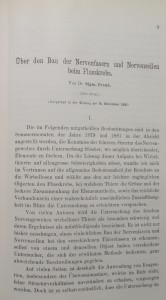Soeben erscheint als Beitrag in den
August 2014
Gerhard Hildebrandt, Christina Ruppert, Martin N. Stienen, Werner Surbeck:
Georg Büchner, Sigmund Freud and the “Schädelnerven” (cranial nerves) – research on the brain and soul in the 19th century
Ich freue mich außerordentlich, dass dieser lange vernachlässigten Fährte nachgegangen wird.
Freud veröffentlichte 1882: „Ueber den Bau der Nervenfasern und Nervenzellen beim Flusskrebs” (On the structure of the nerve fibers and nerve cells in crayfish), einen Text, zu dem mir im März 2011 die Sigmund Freud Privatstiftung noch mitteilte „Aufgrund der Recherche zu Ihrer Anfrage muss ich Ihnen leider mitteilen, dass wir die Promotion bzw. eine Kopie davon leider nicht besitzen. Auch in den Mitteilungen der Akademie der Wissenschaften werden Freuds Arbeiten nicht als Promotion geführt und die Biographen selbst geben auch keinen Hinweis darauf.”
Ich habe den Text schließlich selbst gefunden und sowohl dem Archiv wie dem Freud-Museum zur Verfügung gestellt. S. Freud promovierte mit der Arbeit

Über den Bau der Nervenfasern und Nervenzellen beim Flusskrebs.Vorgelegt in der Sitzung am 15. Dezember 1881.
Veröffentlicht in „Sitzungsberichte der Mathematisch-
Im Abstract der neuen Untersuchung heißt es:
Review of the biographies and medical-scientific, as well as philosophical publications, of Georg Büchner and Sigmund Freud reveal striking parallels between the two researchers in addition to common insights that have generally been ignored or only marginally addressed in the past. Both should be appreciated and remembered as forerunners of today’s neuroscientific community.
Der Aufsatz endet:
Freud was not the first to make the unconscious mind the object of his reflections, but he was the first to develop a structured theory about it. Central for him was the insight that there lay a certain meaningfulness in the symptoms and suffering of his patients. He noticed that the revelation of the contents of the unconscious through free association and engagement with their dreams led to alleviation of symptoms. He therefore saw a central role for psychoanalysis in the discovery of autobiographical contents. To understand dream processes and the formation of neuroses, he designed a model of the “normal” functioning of the psychic apparatus and realized that inner psychological processes follow different rules from what the external reality would suggest. With this Büchner’s idea of the fateful determinism of man experienced a breath of relief from his ”conditio humana.”.
von Peter Brunner

Schreibe einen Kommentar